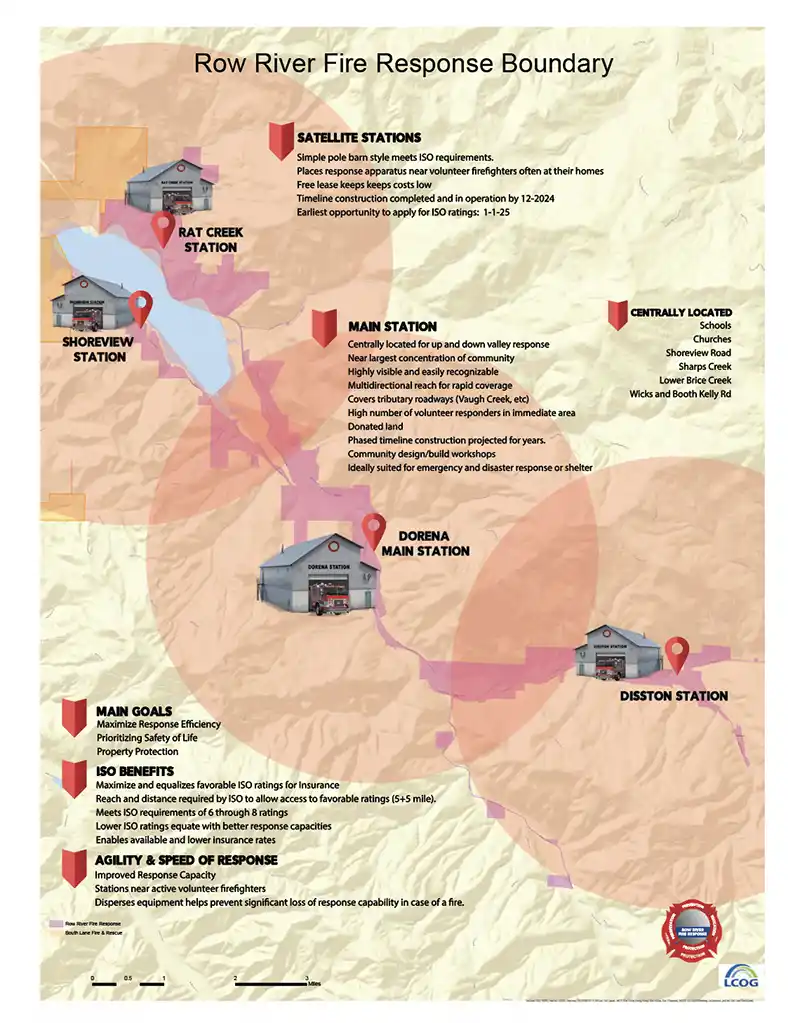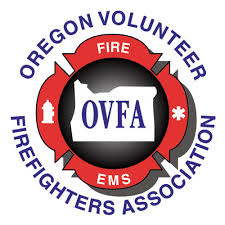Strategic placement of the Row River Fire Stations distributes protection across the 25-mile narrow valley providing fire and EMR services to residents.
Hello Neighbors,
Below are the updates on the fire station plans in our community and progress made
Our main considerations for the design and location of fire stations are:
Overall Safety
- Enable rapid emergency response.
- Prioritizing life safety.
- Protect property.
Strategic Protection
- Strategically placed stations for regional response providing equal protection for all areas.
- Equal distribution of emergency resources that include communication, fire protection, and EMR response.
- Central disaster assembly and shelter-in-place for emergencies or evacuation.
- Improves “ISO fire safety score,” by establishing fire protection to the four quadrants of the Row River. (see map) The insurers then use the improved score to help set homeowners insurance rates.
Different Types of Fire Apparatus for Different Types of Fires
Structural Fire Engine
For structure fires requires a more typical fire engine. (see photo of Disston Engine). These engines have high-capacity water pumps that flow water greater than 1000 gallons per minute. This engine is effective against the very hot conditions seen in structural fires. Each of the four stations will have this type of engine.
Water Tenders and Brush Rigs
Water tenders transport water to the fires for engine use. Brush rigs are necessary for off-road fires, and other vehicle types may be a part of a fire district.
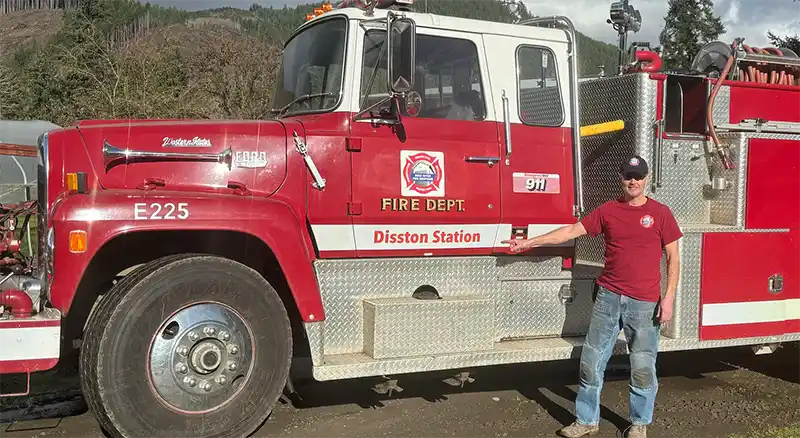
Disston Fire Engine
ISO Rating and the 1-10 Fire Safety Score
The Insurance Services Office (ISO) evaluates fire districts based on their response safety, effectiveness, and capability using a rating scale of 1-10. A lower rating indicates a more effective fire district and a safer community in terms of fire protection. Presently, our valley has a rating of 10, signifying no rated fire service and the lowest safety rating.
By establishing a fire district and fulfilling specific criteria, we have the potential to significantly improve our rating to the 6-8B range. This would represent a considerable enhancement in fire safety for our community, reflecting improved response capabilities and overall effectiveness in addressing fire-related concerns.
Achieving the lowest ISO ratings is a step-by-step process. Here are some examples of the criteria involved:
- Homes covered must be within 5 miles of the fire station.
- Each 5-mile radius must have a certified fire engine with high capacity.
- The engine should be stored in a heated station to prevent freezing.
- Responders should be capable of delivering a minimum of 200 gallons of water per minute for 20 minutes or more, involving water relays, tenders, or river access.
- A minimum of 4 volunteers must respond to a fire.
- The district must have a fire chief.
- To optimize effectiveness, prioritize life safety, and potentially benefit from insurance advantages, we are collaborating with ISO/Verisk in planning for fire station(s).
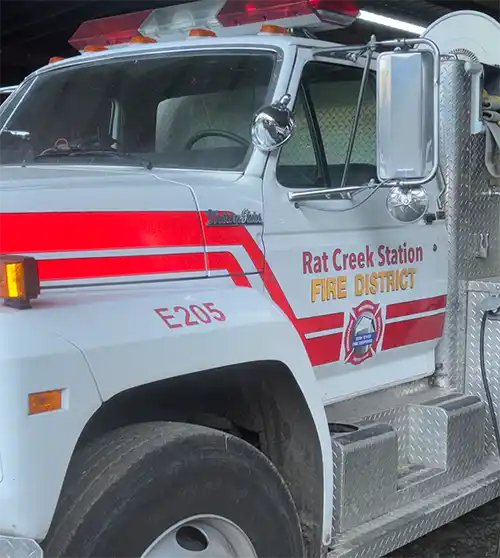
Rat Creek Fire Engine
Row River Fire Stations
After measuring our district area, we looked at potential sites considering both distribution of protection, ISO requirements, and expense. A cost-effective, scheduled plan was developed that includes a main central station and three satellite stations.
Main Station: Dorena Station
The main station will comply with all requirements, and will be located on the flat 35-acre property in Dorena, next to the Dorena Church. It is anticipated to be built in a 3-phased process and is dependent on grant funding.
Main Station Advantages:
- Built on donated property (Upon a successful May 2024 vote.)
- Funded by grants.
- Designed by community participation and input.
- Contains Main Offices, Training, and Volunteer facility.
- Strategically situated in the center of our valley for emergency shelter/evacuation
- Near the highest concentration of residents.
- Storage facility for emergency needs for the community (water, food).
- Generator-powered building for emergency shelter and for those requiring power for medical needs.
Satellite Stations
3 strategically located stations for efficient response in providing equitable fire protection for all upriver residents. These three satellite station locations were selected to maximize rapid fire and EMR protection, cost effectiveness and secure the most favorable ISO ratings.
-
Disston Station: Located at the junction of Layng and Bryce Creek Roads.
-
Rat Creek Station: Located at Rat Creek and Row River Road.
-
Shoreview Station: Location to be determined: ideally near Baker Bay.
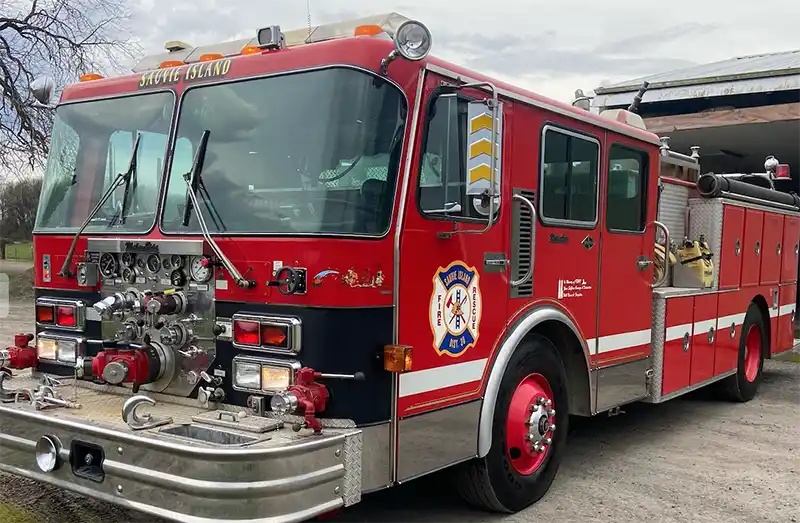
Shoreview Fire Engine
Stations provide ideal coverage throughout the valley–fair to everyone, including coverage of tributary roadways like Vaughn Creek and Sharp’s Creek.
Construction has begun on the Rat Creek Station. Disston station construction will begin late spring. The Shoreview Station awaits engine delivery once the location has been determined.
Satellite Stations Features:
- Simply and inexpensively built pole buildings or may be built on skids for mobility.
- Designed to house an ISO required Fire engine.
- Heated and insulated to meet ISO requirements.
- Enclosed for security.
- Free Lease contracts for Satellite stations–already in place for Rat Creek and Disston Stations.
- Located at Volunteer firefighters’ homes to speed response.
- Earliest application for ISO ratings: January 1, 2025. Our aim is to finish the satellite stations quickly to enhance our response capabilities and be prepared for ISO inspections.
Even before completing the stations, we will deploy the Disston, Shoreview, and Rat Creek engines to their sites as soon as they are ready for response, even if temporarily placed outdoors. This ensures readiness for the summer fire season or structural emergencies. The Disston engine will be deployed in the next few weeks, followed by the Rat Creek engine.
In long, narrow valleys like the Row River Valley, multiple station locations are essential for effective fire and medical response. Our station plan, influenced by advice from similar rural fire districts, caters to these needs.
Check the Row River Response Boundary map for an overview. Shaded circles around the stations show the ISO-required 5-mile maximum. Volunteer firefighters can respond directly from their local station for maximum effectiveness or bring additional support to distant locations.
Our station plan is a cost-effective win for the community! The engines pictured here will be deployed to our satellite stations in the coming weeks.
Please vote to make your community safer. Vote Yes on 20-350!!
Walt Bernard
Row River Fire Response
